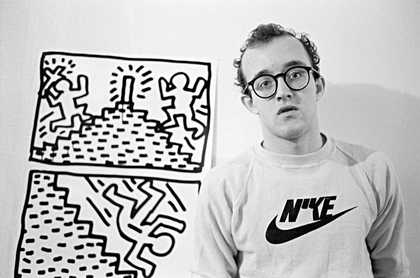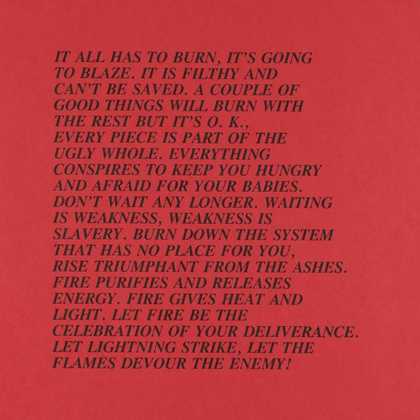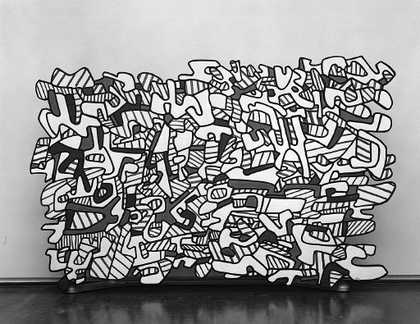I wanted intensity from my art and I wanted intensity for my life. The only place to go was New York. For me, 1978 was a totally fresh beginning. Imagining shadows. Ignoring truth. Blank stare with matching glasses I didn't shave today, and I don't care. Dressing in costumes. Colour is distorted and so is time. I've never seen this face before.
Who cares if you make art? What is making? Seeing is making. Being is making. Not seeing is making. Making is making Only if someone is seeing. The person in the subway is screaming, nobody is listening, but everyone is listening and seeing and making and being.
I had begun to be interested and fascinated by the graffiti I was seeing in the streets and in the subway. Graffiti were the most beautiful things I ever saw. I wanted to let people experience art without having to feel inhibited. It can be touched, felt, manipulated. It is art that is somewhat less serious, less untouchable.
One time, I was in the 51st Street at 7th Avenue subway station drawing when this cop comes up behind me. He arrested and handcuffed me with my hands behind my back. All the cops were wondering what this nerdy white boy could possibly have done. The cop who arrested me says: 'I caught him drawing in the subway'.
The cop at the desk says: 'So you're the guy who does those drawings. Hey Joe, hey Mike, this is the kid who does the subway drawings!'
There was this incredibly raw energy in the air and the energy was called Hip-Hop.
My exhibition at the fun gallery was really a reference to this whole Hip-Hop culture, which had never existed at a gallery opening before. Not only did I meet Andy during this period but also Madonna. The parties I gave in the Broome Street apartment were a mixture of all these scenes. I hope my generation will be able to carry on the magic that this previous generation is excavated and gently tried to teach us.
They have liberated a part of us that is too important to be dismissed and passed over I'm glad I'm different. I'm proud to be gay I am ashamed of my forefathers. I'm not like them. I'm not really scared of AIDS, not for myself. I'm scared at having to watch more people die in front of me again.
People might say if you're not interested in being a part of the system, then you shouldn't care that you're being ignored by the museum's and the curators. I really do believe that it will all happen later, the acceptance.
My support network is not made up of museums and curators but of real people. And that's good because everything I've ever tried to do was cut through all that bullshit anyway.
It seems to me the only thing to do in this world is to do something. The doing is what the world is. But only I can make these things. These things that are called 'The Works of Keith Haring'.
1. His work started on the streets
Keith Haring was a popular artist and activist who was part of the legendary New York art scene during the 1980s. While he is known for his colourful works and his iconic motifs such as the radiant baby and the barking dog, much of his work responded to contemporary social and political events. This included the battle to end Apartheid, the AIDS epidemic and drug abuse. As an openly gay artist Haring also chose to represent the hardships of the LGBTQ community in his work, including gay rights. Inspired by graffiti artists, he began drawing in New York’s subway stations; filling empty poster spaces with chalk drawings which people would walk past every day. His aim was to make art accessible to everyone and these works allowed him to interact with a diverse audience.
All kinds of people would stop and look at the huge drawing and many were eager to comment on their feelings toward it. This was the first time I realized how many people could enjoy art if they were given the chance. These were not the people I saw in the museums or in the galleries but a cross-section of humanity that cut across all boundaries.
Keith Haring
Seeing Haring’s drawings or catching a glimpse of the artist at work in the subway sparked the public’s interest and excitement. It also, however, caught the eyes of police officers. Haring was arrested on a number of occasions for vandalism.
More than once, I’ve been taken to a station handcuffed by a cop who realized, much to his dismay, that the other cops in the precinct are my fans and were anxious to meet me and shake my hand.
Keith Haring
2. Haring had a circle of famous friends
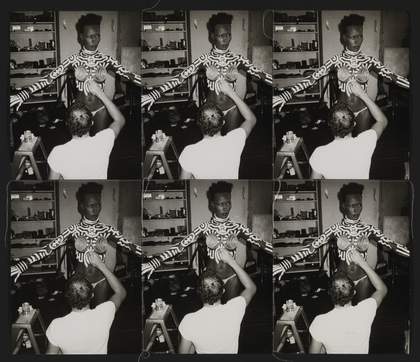
Andy Warhol Grace being painted by Keith 1986. © 2018 The Andy Warhol Foundation for the Visual Arts, Inc. / Artists Right Society (ARS), New York and DACS, London
Living and working in the East Village in New York, Keith Haring had a large social circle, which included many artists and performers who were part of the same underground art scene. This included people such as Madonna, Jean-Michel Basquiat and Andy Warhol, and he frequently worked with them. With growing recognition and popularity, his collaborations expanded to involve other artists, musicians and fashion designers, such as Vivienne Westwood and Malcolm McLaren. Haring’s collaboration with Grace Jones innovatively combined art and fashion. He painted Grace Jones’ body with his graffiti for music performances and also featured in her music video I'm Not Perfect (But I'm Perfect For You).
Haring formed a close friendship with Madonna and, when he was invited to her wedding, he took Andy Warhol as his plus one.
3. His work spread important social and political messages
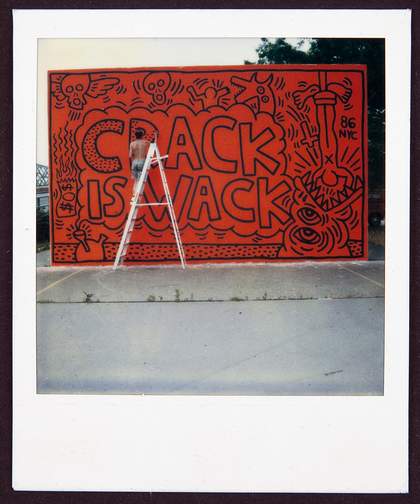
© Keith Haring Foundation
Although his artworks were always colourful and animated, Haring tackled some hard-hitting and challenging subjects concerning people, not just in America but, around the world. Haring used catchy slogans to quickly and effectively make his point. One of his most famous examples is the Crack is Wack mural referring to the crack cocaine epidemic and its effects in New York City. The work was made large enough so that passing cars on the nearby roads would be able to see it.
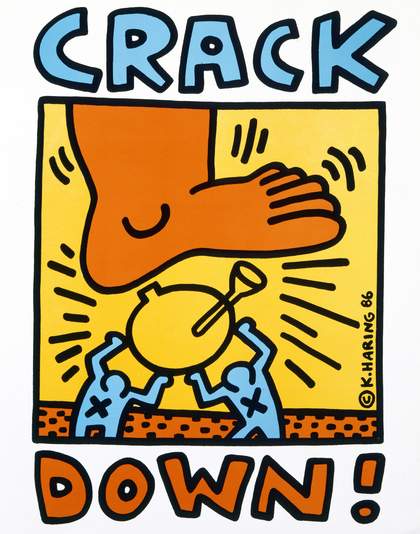
Keith Haring Crack Down! 1986. © Keith Haring Foundation/ Collection Noirmontartproduction, Paris
In 1986 Haring was invited to paint on a section of the Berlin Wall, in an attempt to ‘destroy the wall through painting it’. He painted a bright figurative mural using the colours of the German flag, symbolising the hope of unity between East and West Germany. The work was destroyed in 1989 when the wall was demolished. In 1987 he wrote in his diary
… If it is not regarded as ‘sacred’ and ‘valuable’, then I can paint without inhibition, and experience the interaction of lines and shapes. I can paint spontaneously without worrying if it looks ‘good’; and I can let my movement and my instant reaction/response control the piece, control my energy (if there is any control at all) … It is temporary and its permanency is unimportant. Its existence is already established. It can be made permanent by the camera.
Keith Haring
4. Haring brought fun and colour to the community
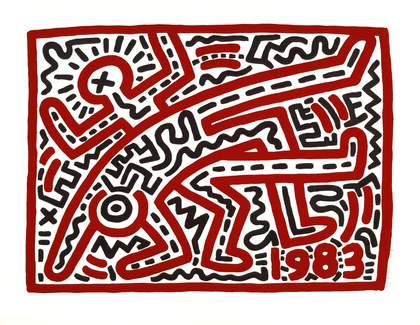
Keith Haring Untitled 1983 © Keith Haring Foundation
Haring loved working with children, admiring their imagination, sense of humour, lack of prejudice and encouraged young people to get together to collaboratively create their own artwork. In 1986 Haring painted a mural with 900 young people to celebrate the Statue of Liberty’s 100th anniversary. It was displayed on the Liberty Tower in Battery Park City.
Haring often collaborated with charities aimed at young people, and he painted murals in lots of children’s hospitals, including the Necker Children’s Hospital in Paris. Haring wrote in his diary:
I made this painting to amuse the sick children in this hospital, now and in the future.
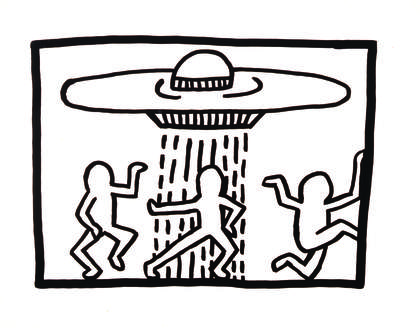
Keith Haring Untitled 1980 © Keith Haring Foundation
Haring had a fun way of working which reflected the content of his work. He often listened to hip-hop music whilst working and painted rhythmic lines to express the movement and energy, which is recognisable in so many of his works. He painted on vinyl tarpaulin, a material often laid on the street and used by break dancers as a surface for their performances.
He was so much fun – I think people forget that. He used to paint one stroke at a time to the rhythm of whatever he was listening to.
Kenny Scharf, artist and friend of Keith Haring
5. He set up the Keith Haring Foundation
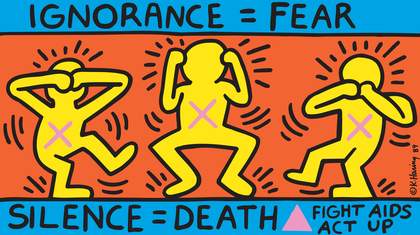
Keith Haring Ignorance = Fear 1989. © Keith Haring Foundation/ Collection Noirmontartproduction, Paris
Haring used his platform as an artist to raise awareness of AIDS. He himself was diagnosed with the disease in 1988. His poster Ignorance = Fear refers to the challenges people who were living with AIDS faced. He wanted to reach as many people as possible and highlight the importance of AIDS education.
Haring set up The Keith Haring Foundation, a year after his diagnosis, to provide funding and support to AIDS research, charities and education.
Keith Haring died of AIDS related complications on 16 February 1990 aged 31. The Keith Haring Foundation continues to strive to meet Keith Haring’s wishes. If you’d like to help support the fight against AIDS, visit the Elizabeth Glaser AIDS Foundation (a partner of The Keith Haring Foundation) to see what you can do.
Visit the Keith Haring exhibition at Tate Liverpool, 14 June 2019 – 10 November 2019

